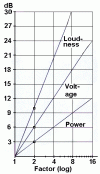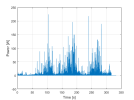JustAnAudioLover
Active Member
- Joined
- Mar 25, 2021
- Messages
- 120
- Likes
- 63
Hi there!
I'm creating this little thread to ask a question for what is probably a very dumb question, but I can't for the life of me figure it out.
Let's say you have speakers rated for 88 dB sensitivity (2.83 V @ 1m).
The speakers' maximum SPL is 112 dB.
Their power rating is 40 to 120 W.
Now, adding 3 dB means doubling the volume. Going (112 - 88) / 3 = 8, so going from 88 dB to 112 dB is multiplying the volume by 2^8, which is 256. Am I correct on that one?
If that's true, then I don't get the numbers in the spec sheet. 1W gives you 88 dB, so to get 112 dB you should need 256W, right? If so, why is the maximum power rating 120W?
I'm sure there's some dumb mistake somewhere in my understanding of how this works, but I'm not sure why.
Could someone please explain me? Thanks
I'm creating this little thread to ask a question for what is probably a very dumb question, but I can't for the life of me figure it out.
Let's say you have speakers rated for 88 dB sensitivity (2.83 V @ 1m).
The speakers' maximum SPL is 112 dB.
Their power rating is 40 to 120 W.
Now, adding 3 dB means doubling the volume. Going (112 - 88) / 3 = 8, so going from 88 dB to 112 dB is multiplying the volume by 2^8, which is 256. Am I correct on that one?
If that's true, then I don't get the numbers in the spec sheet. 1W gives you 88 dB, so to get 112 dB you should need 256W, right? If so, why is the maximum power rating 120W?
I'm sure there's some dumb mistake somewhere in my understanding of how this works, but I'm not sure why.
Could someone please explain me? Thanks


